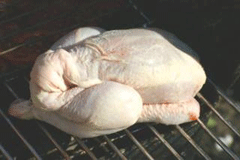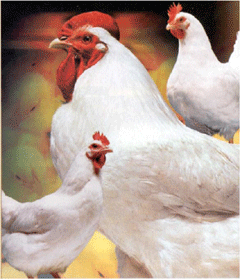Study Raises Concern About Chicken
Air Date: Week of December 15, 2006

A study by Consumer Reports says more than 80 percent of chicken they inspected were contaminated with bacteria and that the U.S. Department of Agriculture is lax in their testing. Host Bruce Gellerman talks with Jean Halloran, director of Food Policy Initiatives at Consumers Union about why bacteria numbers are on the rise and what it means for consumers.
Transcript
GELLERMAN: From the Jennifer and Ted Stanley Studios in Somerville, Massachusetts - this is Living on Earth. I’m Bruce GELLERMAN. Americans love chicken: fried, broiled, barbecued, grilled, fricasseed, or fashioned into fingers. Last year nine billion birds were slaughtered in U.S. processing plants. That’s nearly 90 pounds of chicken per person.
But a new study by the magazine Consumer Reports says what’s on most of the chicken is enough to make you sick.
They found more than 80 percent of the broilers they inspected were contaminated with bacteria even some organically raised chicken were infected with salmonella and campylobacter. Joining me is Jean Halloran, Director of Food Policy Initiatives at Consumer’s Union which publishes the magazine. Ms. Halloran, welcome to Living on Earth.

HALLORAN: Thank you.
GELLERMAN: This is the ninth time Consumer Reports had conducted this study, am I right?
HALLORAN: We’ve been testing since 1998 and these are the worst results we’ve gotten yet.
GELLERMAN: But you found what, more than 83 percent of the chickens you inspected were infected with these bacteria.
HALLORAN: Yes. It was pretty discouraging. 83 percent was infected with either salmonella or campylobacter or both. And this was up from 49 percent four years ago, the last time we tested. What this means for the consumer is that you really have to assume that the chicken you buy is contaminated with something that could make you sick.
GELLERMAN: Why are so many birds infected?
HALLORAN: It’s in our mass production of chicken which gives us good quality chicken at very low prices. You really have to take very serious precautions to prevent disease from ripping through a flock and from contamination at the processing plant.
GELLERMAN: Now, how many chickens did you inspect?
HALLORAN: We tested 525 chickens bought at 100 different supermarkets, gourmet stores and other food merchandisers in 23 states.
GELLERMAN: The reason I ask is because the USDA, at least according to Reuters, a spokesman at the USDA says the sample size was just too small. In fact he says this, quote “they’re passing along junk science and calling it an investigation.”
HALLORAN: Yes. We were really surprised and very disappointed by that reaction from USDA, in part because they really knew nothing about the details of our study design or sampling methodology.
GELLERMAN: But just 525 chickens out of nine billion birds seems like a very small sample size. The USDA, when it does a study, I noticed, back in 2005 it tested 3200 broilers.
HALLORAN: Well, it’s, it’s rather like one of those poling samples where you call 1000 adults and you ask them who they’re going to vote for in the next election. If you structure your sample properly, to be properly representative, then you do get valid and interesting findings. The, the other thing about this is that, is that our results where pretty similar to a number of other tests. In fact, in terms of our results on salmonella, our results were very similar to those of USDA itself. We came up with 15 percent positive, they said last year they got 16 percent positive. In terms of campylobacter, they don’t have an ongoing test program at all so there’s no way to compare our results to theirs.
GELLERMAN: So the government doesn’t test at all for campylobacter?
HALLORAN: It has no ongoing test program and that’s one of the most serious deficiencies, we think. In fact, not only should they be testing but they should be regulating this highly dangerous disease causing organism. Instead they’re just ignoring it.
GELLERMAN: Well, how nasty are these infections, the bacteria campylobacter and salmonella? They can be life-threatening in certain people, right?
HALLORAN: Yes, they can, especially the very young and the very old. Campylobacter causes about 100 deaths a year, salmonella about 600 according to the Center for Disease Control.
GELLERMAN: Well, with you finding that 8 chickens out of 10 have a problem with bacteria I guess we have to assume that all chicken is contaminated, so what can I do?
HALLORAN: There are a number of very important steps that you should always take when you’re buying and cooking chicken. The good news about these bacteria is that if you cook them thoroughly you won’t get sick, it will kill them. So, what you have to do is when you buy chicken in the store make sure it’s wrapped well and is not in your grocery bag in a way that it’s dripping on anything else. And the same goes for when you’re storing it in the refrigerator. Then when you take it out and you’re going to eat it you cut it up. And as soon as you’re done cutting it you take the cutting board and your knife, throw them in the sink and wash them and wash your hands.

Then you need to really cook the chicken thoroughly. Make sure there’s no little piece sticking on the back of the barbeque grill. And absolutely never put the chicken from the grill back on the platter that you brought it out in. This is something that people often do especially near the barbeque.
GELLERMAN: Guilty as charged. Well, Mrs. Halloran thank you very much.
HALLORAN: Well, thank you.
GELLERMAN: Jean Halloran is director of food policy initiatives at Consumer’s Union. A U.S. Department of Agriculture spokesperson was not available to comment in time for our broadcast. But, the department is going to start a study of campylobacter in chicken in January.
Links
Living on Earth wants to hear from you!
Living on Earth
62 Calef Highway, Suite 212
Lee, NH 03861
Telephone: 617-287-4121
E-mail: comments@loe.org
Newsletter [Click here]
Donate to Living on Earth!
Living on Earth is an independent media program and relies entirely on contributions from listeners and institutions supporting public service. Please donate now to preserve an independent environmental voice.
NewsletterLiving on Earth offers a weekly delivery of the show's rundown to your mailbox. Sign up for our newsletter today!
 Sailors For The Sea: Be the change you want to sea.
Sailors For The Sea: Be the change you want to sea.
 The Grantham Foundation for the Protection of the Environment: Committed to protecting and improving the health of the global environment.
The Grantham Foundation for the Protection of the Environment: Committed to protecting and improving the health of the global environment.
 Contribute to Living on Earth and receive, as our gift to you, an archival print of one of Mark Seth Lender's extraordinary wildlife photographs. Follow the link to see Mark's current collection of photographs.
Contribute to Living on Earth and receive, as our gift to you, an archival print of one of Mark Seth Lender's extraordinary wildlife photographs. Follow the link to see Mark's current collection of photographs.
 Buy a signed copy of Mark Seth Lender's book Smeagull the Seagull & support Living on Earth
Buy a signed copy of Mark Seth Lender's book Smeagull the Seagull & support Living on Earth

